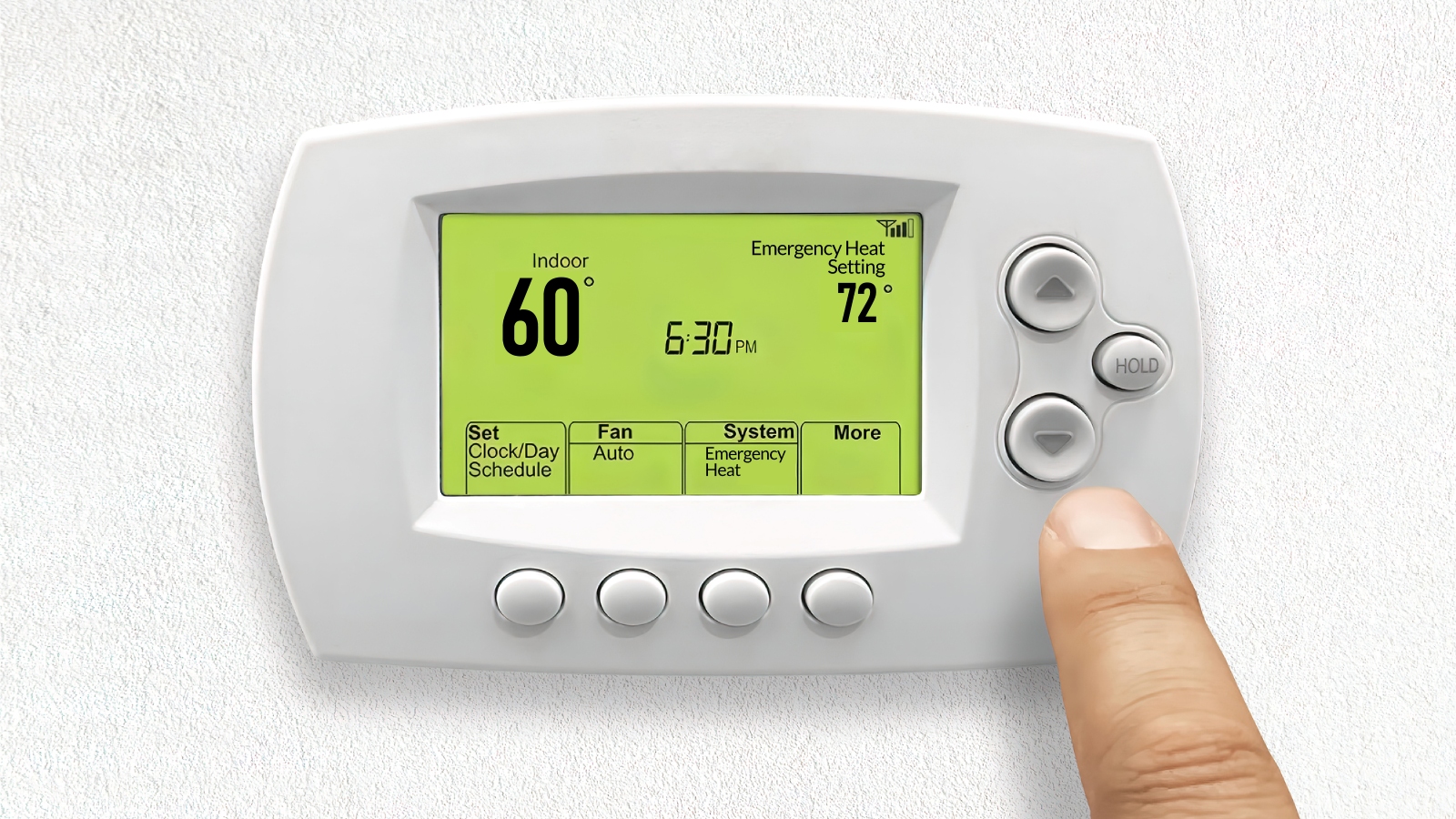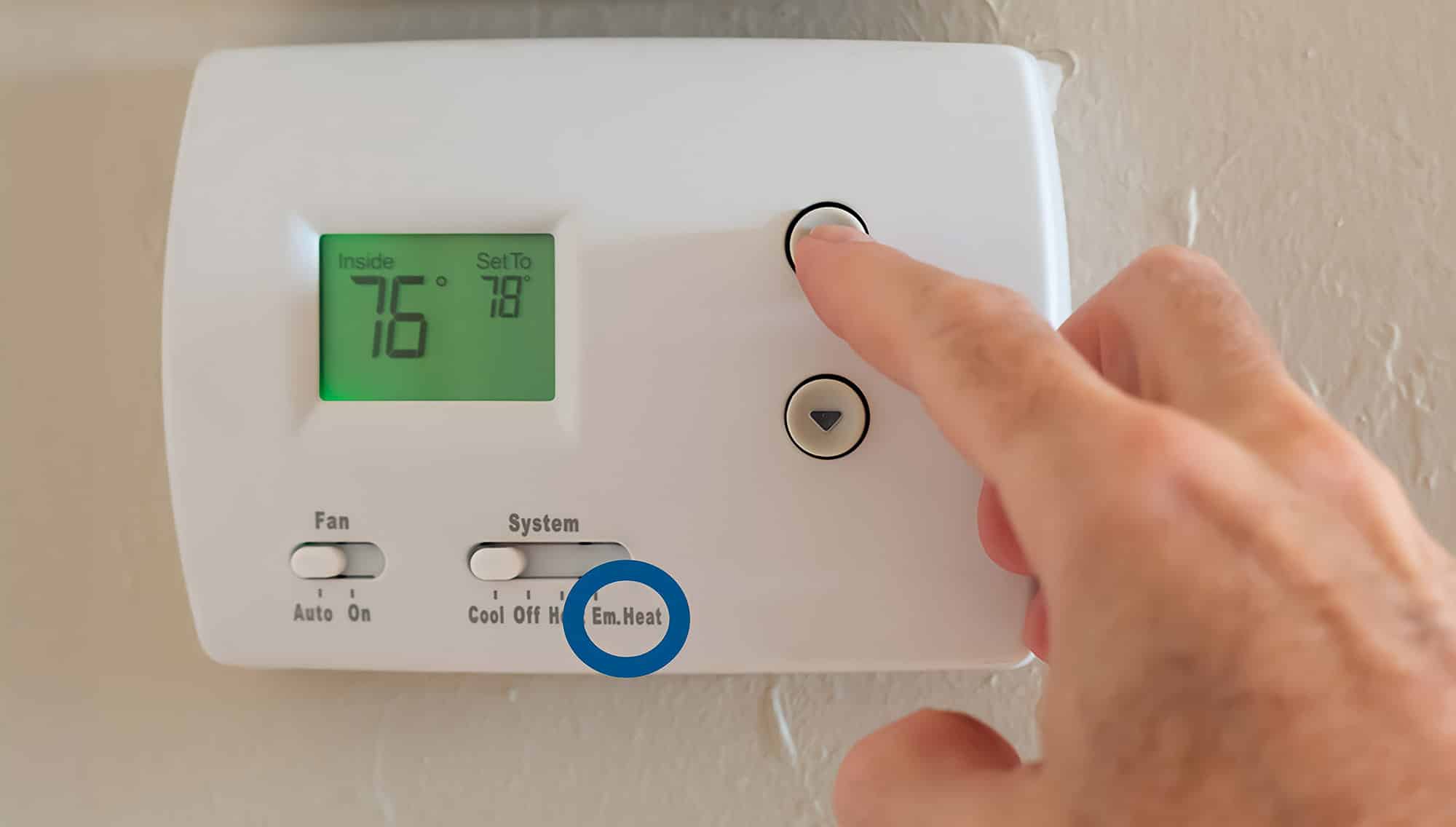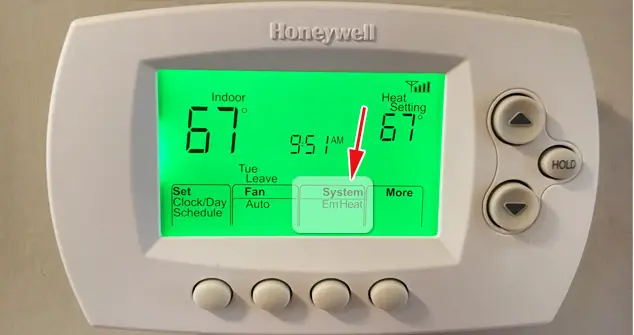Check Best Thermostat Pricing in Amazon
** As an Amazon Associate, I earn from qualifying purchases.
Emergency heat on the thermostat is a backup heating option. It activates when your heat pump can’t warm your home.
Let’s delve into why this feature is crucial, especially during extreme cold weather. Understanding emergency heat is important for homeowners. This setting ensures your home stays warm even if the main system fails. Typically, emergency heat uses electric or gas heating elements.
It’s more expensive to run than the standard heat pump. Knowing when to use emergency heat can save you money and keep your home comfortable. This guide will explain how it works and when to use it, ensuring you’re prepared for those cold winter nights. Stay cozy and informed with our detailed look at emergency heat on your thermostat.

Credit: charlottecomfortsystems.com
How Emergency Heat Works
Emergency heat on the thermostat activates when the main heating system fails. It uses electric resistance heating to warm your home. This feature ensures you stay comfortable in cold weather.
When the temperature drops, understanding how emergency heat works can be a lifesaver. Emergency heat, often found on heat pump thermostats, is a backup heating system that kicks in during extreme cold or when your main system fails. Here’s how it functions to keep your home warm when you need it most. ###Mechanism Behind It
Emergency heat works by activating an auxiliary heating source. This source is usually electric resistance coils or a gas furnace. When your heat pump can’t pull enough heat from the outside air, the thermostat switches to emergency heat mode. This secondary system then provides the warmth needed to maintain your home’s temperature. In my experience, when we had a sudden cold snap, our heat pump struggled. Switching to emergency heat made a noticeable difference in just a few hours. ###Differences From Regular Heat
Regular heat uses the heat pump to transfer heat from outside to inside. It’s energy-efficient and ideal for milder climates. Emergency heat, however, uses more energy. It’s designed for short-term use during extreme conditions. Relying on it too long can spike your energy bills. Imagine your heat pump as a marathon runner and emergency heat as a sprinter. The runner is great for long distances, but the sprinter is best in short bursts. Understanding how and when to use emergency heat ensures your home stays cozy without breaking the bank. How do you balance comfort and cost during the winter months?Signs You Need Emergency Heat
Emergency heat is essential when your primary heating system fails. Signs include unusual cold spots, a constantly running system, or no heat.
When winter strikes, your thermostat becomes your best friend. But what if you need more than just a slight temperature adjustment? That’s where emergency heat comes in. It’s crucial to know when to use this feature to keep your home warm and comfortable. Let’s explore the signs that indicate you might need to switch on the emergency heat.Temperature Drops
One clear sign that you need emergency heat is a significant drop in temperature. If you notice that your home isn’t warming up despite the thermostat being set to a high temperature, it might be time to use emergency heat. For example, you set your thermostat to 70°F, but the indoor temperature stubbornly stays at 60°F. This is a strong indicator that your regular heating system is struggling. It’s essential to act quickly in these situations. Prolonged exposure to cold can be uncomfortable and even dangerous, especially for young children and the elderly.Hvac System Issues
Another sign is if your HVAC system is having issues. Have you heard unusual noises coming from your heating unit? Or maybe the system turns on and off frequently, but your home remains cold. These could be signs that your heat pump is malfunctioning. In my experience, a loud clanking noise from the HVAC system was the first clue. It turned out the heat pump was overworked and couldn’t keep up with the frigid temperatures outside. Switching to emergency heat in such scenarios can provide immediate warmth while you schedule a repair for your system. It acts as a backup to ensure you’re not left in the cold. Have you ever wondered if those minor HVAC issues could lead to bigger problems? They often do if left unchecked. Using emergency heat can be a temporary solution while you address the root cause. By being alert to these signs, you can ensure a cozy and safe environment for you and your loved ones. Keep an eye on temperature drops and listen for any odd sounds from your HVAC system. Your comfort and safety are worth it.Pros And Cons
Understanding the pros and cons of using emergency heat on your thermostat helps you make informed decisions. It’s essential to know both the benefits and drawbacks. This way, you can use emergency heat effectively.
Benefits
Emergency heat is great for those really cold days. It provides instant warmth. This system is a backup. If your main heating system fails, you won’t be left in the cold. Emergency heat often uses electric resistance heating. This method is reliable. It operates independently of the main heat pump. That means you have a safety net during extreme weather.
Drawbacks
Emergency heat can be expensive. It uses more electricity than your regular heating system. This increases your energy bills. Also, overuse can lead to higher costs. Emergency heat is not as efficient. It quickly warms your home but uses a lot of energy. Only use it when necessary. Over-reliance can stress your heating system. This can lead to potential damage. Always return to regular heat once the emergency passes.
Common Misconceptions
Understanding emergency heat on your thermostat can be confusing. There are many misconceptions that can lead to inefficient use and higher energy bills. Let’s break down some common myths and facts to clear things up.
Myths
Many people think that emergency heat is a faster way to heat your home. This isn’t true. It’s designed as a backup and not for regular use.
Another myth is that emergency heat saves money. Actually, it uses more electricity and can cause your bills to skyrocket.
Some believe that if their heat pump isn’t warming their home fast enough, switching to emergency heat will help. This is misleading. It should only be used when the heat pump is malfunctioning.
Facts
Emergency heat is a secondary heating source. It’s meant for use when your primary heating system fails.
Using emergency heat will automatically turn off your heat pump. Your system will rely solely on electric resistance heating, which is less efficient.
It’s important to understand your specific thermostat. Some thermostats have a light or indicator to show when emergency heat is on. Always check your manual for details.
Have you ever wondered why your energy bill is so high in winter? It might be because your emergency heat is on without you realizing it. Regularly check your thermostat settings to avoid this costly mistake.
Remember, emergency heat is for emergencies. Use it wisely to save on energy costs and keep your home comfortable.
Maintenance Tips
Maintaining your thermostat, especially the emergency heat function, ensures it runs efficiently. Regular maintenance helps you avoid costly repairs and unexpected breakdowns. Here are some practical tips to keep your system in top shape.
Regular Checks
Regularly check your thermostat settings to ensure they are accurate. A simple mistake can cause your system to overwork.
Check Best Thermostat Pricing in Amazon
** As an Amazon Associate, I earn from qualifying purchases.
Inspect the thermostat batteries. Weak batteries can lead to malfunctioning, especially when you need it the most.
Keep the area around your thermostat clean. Dust and debris can interfere with its sensors and affect performance.
Test your emergency heat mode periodically. This ensures it works correctly when you need it.
Professional Service
Schedule an annual check-up with a professional. They can detect issues you might overlook.
A technician can clean and lubricate parts that need it. This keeps the system running smoothly.
Professional services often offer maintenance plans. These plans provide regular check-ups, saving you from last-minute repairs.
Have you ever had an emergency heat failure? Regular professional service can prevent such stressful situations.
By following these tips, you ensure your emergency heat is reliable. Your thermostat will thank you, and so will your wallet.

Credit: craigheadelectric.coop
Energy Efficiency
Emergency heat on your thermostat can affect energy efficiency. It’s essential to understand its impact on your energy bills and how you can save money. Let’s dive into the details.
Impact On Energy Bills
Emergency heat consumes more energy than regular heating. It relies on electric resistance heating, which is less efficient. This can lead to higher energy bills, especially during cold months. Monitoring your thermostat settings is crucial for managing energy consumption.
Saving Strategies
There are ways to use emergency heat efficiently. First, only use it when necessary. Regularly maintain your heating system to ensure it’s working correctly. Insulate your home to keep heat inside and reduce the need for emergency heat. Consider installing a programmable thermostat to manage temperature settings better. These strategies can help lower your energy bills and improve overall efficiency.

Credit: www.watkinsheating.com
Frequently Asked Questions
Is It Ok To Run Emergency Heat?
Yes, it’s OK to run emergency heat. Use it when your heat pump fails. It provides temporary warmth.
When Should I Use The Emergency Heat Setting On My Thermostat?
Use the emergency heat setting during extreme cold when your heat pump fails. Only use it if absolutely necessary.
What Causes Emergency Heat To Come On?
Emergency heat activates when the primary heating system fails or struggles. It can also turn on during extremely cold weather.
Does Emergency Heat Cost More To Run?
Yes, emergency heat typically costs more to run. It uses electric resistance heating, which is less efficient and more expensive than standard heat pump operation.
Conclusion
Emergency heat on the thermostat is a handy feature. It provides extra warmth during extreme cold. Simple to use, it ensures your home stays cozy. Always check your system for the emergency heat option. Knowing how to use it can save you trouble in winter.
It’s a great tool for keeping your family comfortable. Stay prepared and keep your home warm. Understanding your thermostat’s features helps in managing your heating system better. Keep this guide in mind for a warmer, safer home.
Check Best Thermostat Pricing in Amazon
** As an Amazon Associate, I earn from qualifying purchases.


